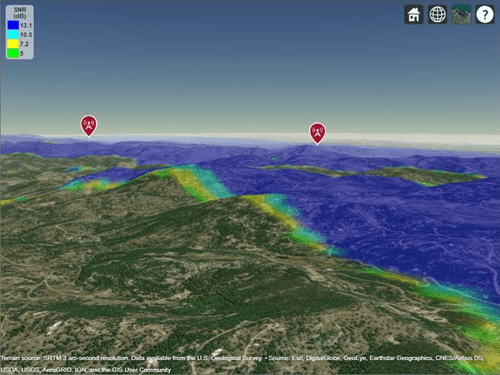Radar
Radar engineering teams use MATLAB® and Simulink® to design, analyze, simulate, and test multifunction radar systems. Combine Radar Toolbox with other products to reduce development time, eliminate design problems early, and streamline analysis and testing for airborne, ground-based, maritime, and automotive radar systems.

Develop models that support the full life cycle of radar systems:
Perform link budget analysis, model architectures, and evaluate system design trade-offs
Create georeferenced scenarios and simulate radar signals, detections, and tracks
Design signal and data processing chains for different waveforms and phased array front-ends
Automatically generate HDL or C code for prototyping and deployment
Products for Radar
Topics
Radar Systems Engineering
- Radar Link Budget Analysis (Radar Toolbox)
Use the Radar Designer app to perform a link budget analysis when designing a radar system. Set the radar performance requirements, compute radar metrics, configure the environment, and compare several alternative designs. - Radar Architecture: System Components and Requirements Allocation (Part 1) (Radar Toolbox)
Starting from a set of performance requirements, design, implement, and test a radar system in Simulink. - Define and Test Tracking Architectures for System-of-Systems (Sensor Fusion and Tracking Toolbox)
This example shows how to define the tracking architecture of a system-of-systems that includes multiple detection-level multi-object trackers and track-level fusion algorithms.
Radar Scenario Simulations
- Radar Performance Analysis over Terrain (Radar Toolbox)
The performance of a radar system can depend on its operating environment. This example shows how radar detection performance improves as target elevation increases above the terrain. - Simulate and Track Targets with Terrain Occlusions (Sensor Fusion and Tracking Toolbox)
This example shows you how to model a surveillance scenario in a mountainous region where terrain can occlude both ground and aerial vehicles from the surveillance radar. - Simulated Land Scenes for Synthetic Aperture Radar Image Formation (Radar Toolbox)
Simulate of an L-band remote-sensing SAR system by generating IQ signals from a scenario containing three targets and a wooded-hills land surface and then processing the returns using a range migration focusing algorithm.
Multifunction Radar
- Adaptive Tracking of Maneuvering Targets with Managed Radar (Radar Toolbox)
This example employs radar resource management to efficiently track multiple maneuvering targets. An interacting multiple model (IMM) filter estimates when the target is maneuvering to optimize radar revisit times. - Multibeam Radar for Adaptive Search and Track (Radar Toolbox)
UseradarDataGeneratoras part of a closed-loop simulation of a multifunction phased array radar (MPAR) tracking multiple maneuvering targets. At each update interval the radar requests resources from the MPAR to search for targets and revisit existing tracks. - Track Space Debris Using a Keplerian Motion Model (Sensor Fusion and Tracking Toolbox)
This example shows how to model earth-centric trajectories using custom motion models withintrackingScenario, how to configure afusionRadarSensorin monostatic mode to generate synthetic detections of space debris, and how to setup a multi-object tracker to track the simulated targets.
Radar Antennas, Beamforming, and Waveforms
- Modeling Mutual Coupling in Large Arrays Using Embedded Element Pattern (Phased Array System Toolbox)
Model mutual coupling effects between array elements by using an embedded pattern technique. The example models an array two ways: (1) using the pattern of the isolated element or (2) using the embedded element pattern, and then compares both with the full-wave Method of Moments (MoM)-based solution of the array. - Conventional and Adaptive Beamformers (Phased Array System Toolbox)
Apply three beamforming algorithms to narrowband array data: the phase shift beamformer, the minimum variance distortionless response (MVDR) beamformer, and the linearly constrained minimum variance (LCMV) beamformer. - Radar and Communications Waveform Classification Using Deep Learning (Phased Array System Toolbox)
Classify radar and communications waveforms using the Wigner-Ville distribution (WVD) and a deep convolutional neural network (CNN).
Code Generation and Deployment
- FPGA-Based Range-Doppler Processing - Algorithm Design and HDL Code Generation (Phased Array System Toolbox)
Design a range-Doppler response that is implementation-ready for a FPGA and compare a simulation output of the model with a Simulink behavioral model. - Processor-in-the-Loop Verification of JPDA Tracker for Automotive Applications (Sensor Fusion and Tracking Toolbox)
Generate embedded code for a JPDA tracker and verify it using processor-in-the-loop (PIL) simulations.





